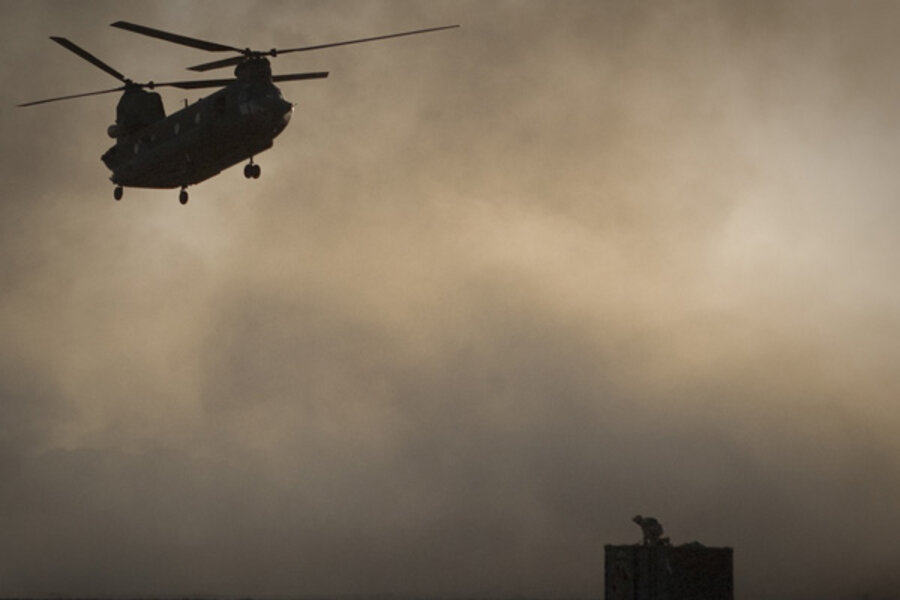Navy SEALs: Afghan helicopter crash investigation begins
Loading...
| Kabul, Afghanistan
International military forces worked on Monday to recover every last piece of a Chinook helicopter that crashed over the weekend, killing 30 American troops, seven Afghan soldiers and an Afghan interpreter, NATO said.
German Brig. Gen. Carsten Jacobson, a spokesman for the U.S.-led coalition, told reporters that troops had secured the crash site in a rugged area of eastern Wardak province and nobody was being allowed in or out of the area while the investigation was ongoing.
Jacobson said the coalition still had not yet determined the exact cause of the crash, but some officials have said the heavy and lumbering transport helicopter was apparently shot down. Officials said the helicopter was hit as it was flying in and approaching the area.
"We are still investigating this incident so we have no picture of what was the cause for the incident. That is what the investigation is basically all about," Jacobson said.
The helicopter was ferrying a group of Navy SEALs to reinforce a group of Army Rangers who were under fire. It remains unclear if the Rangers and SEALs were taking part in a night raid to capture or kill an insurgent leader.
It was deadliest single loss for U.S. forces in the decade-long war.
Another NATO helicopter made a hard landing Monday in eastern Paktia province, the U.S.-led coalition said. It did not report any casualties and said the cause of the hard landing was under investigation. The coalition said there was no enemy activity in the area at the time.
The helicopter was a CH-47 of the same type that crashed on Saturday. It was flying in to pick up special operations troops, but apparently suffered a mechanical failure and crash landed, an officer in the war zone said. He could not be named because he was not authorized to comment publicly. The crew was rescued by the troops.
The fatal crash on Saturday highlights the risks confronting the U.S.-led coalition as it looks to rely more on special operations forces while reducing the overall number of troops in Afghanistan by the end of 2014.
A current and a former U.S. official said the Americans included 22 SEALs, three Air Force members and a dog handler and his dog. The two spoke on condition of anonymity because military officials were still notifying the families of the dead.
All but two of the SEALs were from SEAL Team 6, the unit that killed Osama bin Laden in Pakistan last May, officials said on condition of anonymity because they were not authorized to release the information. None of the SEALs killed in the crash took part in the bin Laden mission.
The Rangers, special operations forces who work regularly with the SEALs, secured the crash site in the Tangi Joy Zarin area of Wardak province, about 60 miles (97 kilometers) southwest of Kabul, one of the officials said.
Many of the officials spoke on condition of anonymity because the investigation was still ongoing.
Eight Taliban fighters were also killed in the battle, Taliban spokesman Zabiullah Mujahid said in a statement.
Jacobson said that despite the tragedy, the coalition was undeterred in its mission.
"The incident, as tragic as it was in its magnitude, will have no influence on the conduct of operations. It was a tragic day. It was a tragic loss," Jacobson said. "The campaign is going to continue. We will continue to relentlessly pursue the enemy in the fight that we are taking to them."
SEALs, Rangers and other special operations troops are expected to be the vanguard of the American military effort in Afghanistan as international military forces start pulling out, handing over control to the Afghan forces they have spent billions of dollars arming and training.
Special operations troops are expected to remain in the country after the troop withdrawal for counterterrorism missions and advisory support. Just how many will remain has not yet been negotiated with the Afghan government, but the United States is considering from 5,000 to 20,000, far fewer than the 100,000 U.S. troops there now.
Special forces are frequently used to target insurgent commanders as part of an effort to force the Taliban's leadership to agree to a negotiated peace. The operations, mostly night raids, are often carried out by Afghan and coalition special operations forces.
Night raids have drawn criticism from human rights activists and infuriated Afghan President Hamid Karzai, who says they anger and alienate the Afghan population.





